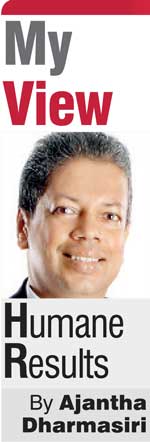Sunday Apr 20, 2025
Sunday Apr 20, 2025
Monday, 4 September 2017 00:00 - - {{hitsCtrl.values.hits}}
Disruptive technologies drive digital initiatives in diverse fields. The people-centric function of Human Resource Management (HRM) cannot escape from this wave of disruption. How do such disruptions challenge HR policies and practices, globally and locally? Today’s column is an attempt to explore it in detail.

The HR technology landscape is exploding with growth and innovation
Overview
It was Joseph Schumpeter, the Austrian-American economist, who first spoke of a “gale of creative destruction” in order to sustain economic growth. We can see a parallel to that in the now popular use of the term “disruption”.
Prof. Clayton Christensen of Harvard Business School, who is widely regarded as the concept initiator of disruption, says that a disruption displaces an existing market, industry, or technology and produces something new and more efficient and worthwhile. Whilst being disruptive on one hand, it is creative on the other hand.
“We are witnessing profound shifts across all industries, marked by the emergence of new business models, the disruption of incumbents and the reshaping of production, consumption, transportation and delivery systems,” observes Klaus Schwab, in his most recent book, ‘Fourth Industrial Revolution’.

He further explains: “We have yet to grasp fully the speed and breadth of this new revolution. Consider the unlimited possibilities of having billions of people connected by mobile devices, giving rise to unprecedented processing power, storage capabilities and knowledge access. Or think about the staggering confluence of emerging technology breakthroughs, covering wide-ranging fields such as artificial intelligence (AI), robotics, the internet of things (IoT), autonomous vehicles, 3D printing, nanotechnology, biotechnology, materials science, energy storage and quantum computing, to name a few.” (Schwab, 2014: 1)
As Forbes magazine reports, the HR technology landscape, which is now a more than $ 15 billion market in software, is exploding with growth and innovation. “We are tracking more than 100 new startups in social and referral recruiting, talent analytics, assessment science, online learning, and mid-market core HR systems.”
These new tools to help manage employee communications, engagement, recognition, and workplace wellness are also in very high demand.
It is in this context, the term “disruptive HRM” becomes appropriate. Let’s explore further.
Dissecting the “disruptive HRM”
What is disruptive HRM all about? It is essentially challenging the conventional way of doing things. It also involves new initiatives with the use of technology in moving beyond traditional boundaries. “On the spot” feedback, which is real time and online as opposed to annual performance appraisal, is one such example.
The term disruption is associated with radical change. The same should apply to disruptive HRM. The definition of HRM coined for Sri Lanka through a series of deliberations at the Institute of Personnel Management (IPM) can be stated as follows:
A strategic and integrated approach in acquisition, development and engagement of talent, using relevant tools, with proper policies, practices and processes in creating a conducive climate towards achieving organisational excellence and societal well-being (IPM, 2014).
As the above definition revolves around talent, the disruptive HRM should focus on unorthodox ways of “winning the war for talent”. Use of social media such as LinkedIn for hiring talent is one such way. Use of online learning tools as opposed to traditional training is another. Facing triple challenges of being lean, seen and green can be confidently done through disruptive HRM.

Being lean through disruptive HRM
There is a wave of becoming faster, cheaper, better in an increasingly competitive global scene. HR cannot avoid its influence. Stemming from the Japanese concept of creating value by eliminating waste, lean management has spread its wings to cover both manufacturing and service sectors.
Gone are the days that HR was “humanly rich” as a department with all sort of people, mostly dumped by the seniors. Efficiency with regard to optimising cadre, in clearly identifying the needs and the specific roles associated is of utmost importance.
Lean management is in fact a philosophy derived mostly from the Toyota Production System (TPS). There is an assortment of techniques available in making the processes cost effective. They can be appropriately adapted by HR for serving the organisation better.
For example, there is the use of “value stream map”, which shows the current steps, delays, and information flows required to deliver the target product or service. This may be a production flow (raw materials to consumer) or a design flow (concept to launch). HR needs to identify their value stream maps regarding the areas such as recruitment, selection, training and performance management.
One important thing to remember is that HR has to work hand-in-hand with other functional departments in being lean. With the increased use of analytical tools, data-driven decisions can be reached in overcoming disputes.
Being seen through disruptive HRM
We are increasingly moving towards a virtual world of work. There are a variety of flexible technologically connected but geographically separated. A global virtual team might have members based in New York, New Delhi and New South Wales. Telecommuting is an arrangement where a person can work from home by connecting through technology without physically coming to work. In fact, digitalisation prompts HR to be more tech-savvy in strengthening the connections. Based on my research with two US-based colleagues, it was evident that one major challenge in a virtual team arrangement is to trust each other. If you have worked with someone physically in the same office at least for some time, they found it easier to work as a virtual team. The challenge was to interact with relatively unfamiliar members of the team in a distant location.
It is an interesting HR scenario in this context. Each member of the virtual team based in different locations has to be governed by their local labour laws and other local HR practices. At the same time, there is a global HR strategy. Hence, it is a case of think globally and act locally with regard to HR practices pertaining to virtual team arrangements.
Why is the “seen” factor so important to HR? The answer lies in the nature of virtual teams and telecommuting workforce. They are the new net-centric nomads. Nomads, in the sense that their work desk can be a seat in an airplane with laptop or palmtop connected to the internet. For them, what matters is connectivity more than location.
Their daily HR functions are carried by a supervisor, also in a remote location. Some of the virtual team members have not seen the central HR colleagues, after their initial hiring discussion. On one hand, it is good to delegate and to make every manager a people manager. However, on the other hand, the vibrant presence of the HR as a guiding and facilitating function is also essential. Such a scenario leads to a visibility issue. How can HR show its availability for coaching, training, performance advice and other matters? Is it practically possible to meet all employees scattered all over? What should be the best cost-effective arrangement? These are some of the questions that HR professionals have to find answers.
Being green through disruptive HRM
We are living in world where nature has begun to strike back. Chaotic weather patterns across the globe are a grim reminder that eco-friendly practices of work need a lot more attention. What matters is not only profits and people, but planet as well. Obviously, the now-famous triple bottom line concept has much impact to HR.
Some common green human resource initiatives in the West include using web or teleconferencing to reduce travel, promoting the reduction of paper use and implementing wellness programs to foster employees’ proper nutrition, fitness, and healthy living.
The important point here is the need to integrate green initiatives with lean and seen initiatives. In other words, they are not three isolated sets of actions but one holistic path. Take paper reduction for an example. Instead of having piles of personnel files in a store room, a well-designed HR information system (HRIS) will do the needful in a much more effective manner. It is a case of being lean and green at the same time.
By being green, HR has to foster SHE, meaning Safety, Health and Environment. A healthy workforce which performs duties with safety in mind and without polluting the environment is the growing need of our workplaces.
Policy is like an umbrella guiding the practices within. Future HR policies need to be green. So should be their practices. Take recruitment for an example. Minimising the use of paper by resorting to more IT-based techniques is becoming popular. Training employees on energy conservation and making them more environmentally conscious are also vital actions HR can do. Here again, eliminating waste as a way of saving energy appear prominently, highlighting the link between ‘be green’ and ‘be lean’.
Way forward
Disruptive HRM is here in a decisive way. Aptly intertwined with being lean, seen and green, it should be viewed holistically in the broad context of socio-economic and religio-cultural fabric of Sri Lanka. It should cater for organisational progress as well as societal wellbeing. The conventional mindset of ‘labour handling’ should pave the way for the creative mindset of ‘talent engagement’. Are Sri Lankan HR professionals ready for such a challenging change? Are private sector managers and public sector administrators willing to embrace such change? Are Sri Lankan leaders inspiring such change with timely decision making? These are the pertinent questions that need prompt attention.
(Prof. Ajantha Dharmasiri can be reached through [email protected], [email protected] or www.ajanthadharmasiri.info.)